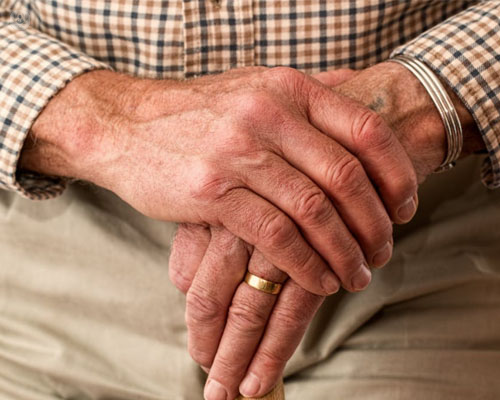

What is essential tremor?
Essential tremor, or familial tremor, is a progressive neurological pathology. It is a movement disorder characterised by a rhythmic movement or shaking of the hands, head, legs, or even the voice.
It is estimated that 1 in 20 people over the age of 40, and 1 in 5 people over the age of 65 suffer from essential tremor. It most commonly affects people over 40 but it can occur at any age.

There are two main types of essential tremor:
- Kinetic tremor : this occurs during a voluntary movement (for example, bringing food or an object to the mouth).
- Postural tremor: occurs while maintaining a position against gravity (extending the arms and holding them in that position, bringing the hand or arm closer to the body, etc.).
Most people with essential tremor have both postural tremor and kinetic tremor.
Essential tremor is often associated with Parkinson's disease. This is somewhat justified, as motor symptoms are the primary manifestations of Parkinson's, the most common being tremor. However, even if you have involuntary tremors this does not mean that you have Parkinson's. In fact, it is important to consider these differences between essential tremor and Parkinson's:
- Tremor in Parkinson’s occurs when you are at rest, but essential tremor occurs when you are physically active or moving around.
- Other motor symptoms are associated with Parkinson's including stiffness and slowness
- Essential tremor affects the head, but in Parkinson’s the head is unaffected
Prognosis of the disorder
Essential tremor is not life-threatening, but it does affect the quality of it. People who suffer from essential tremor may lose the ability to perform simple tasks, such as driving or going to work.
Medical tests for essential tremor
Your medical history will be taken and a physical and neurological examination performed. The physical examination will assess:
- Whether the tremor occurs when the muscles are in action or at rest
- The location of the tremor (where in the body it occurs)
- The nature of the tremor (frequency and extent of the tremor).
The neurological examination will evaluate any alterations in balance, speech anomalies, and increased muscle stiffness.
Additional tests may help determine any functional limitations. A common test for essential tremor is to ask you to draw a spiral. This evaluates your psychomotor skills. Your ability to write by hand and grasp certain objects, as well as exercises such as touching the tip of your nose with your finger, are also used to evaluate an alteration of the motor system.
What causes essential tremor?
Essential tremor is the consequence of abnormal communication between different parts of the brain. However, the exact cause of this miscommunication is unknown.
Essential tremor is hereditary in most cases. It is estimated that a child of a parent with essential tremor has a 50% chance of inheriting the gene. However, not everyone who inherits the gene will develop the disorder.
Can it be prevented?
Essential tremor cannot be prevented – it is a neurological disorder that develops without warning. However, it can be prevented from severely affecting your life, in that you can adapt your daily life to make it as comfortable as possible.
It is best to use objects that are solid, easy-to-grasp and close securely, and deep containers so that you can avoid filling them to the brim and the contents spilling out. Shaking is reduced when using heavy objects with large handles.
There are also other already adapted everyday items that can be useful (cutlery or pens, for example), as well as electric toothbrushes, and velcro to fasten your shoes more easily and make your life easier.
Treatments for essential tremor
There is currently no treatment that cures essential tremor or prevents it from developing. Treatment for essential tremor is aimed at reducing the severity of the symptoms and improving the functioning of the locomotor system. This is combined with medication, usually antiepileptics, anticonvulsants and psychotropic drugs that have a mild sedative and relaxing effect.
If you do not respond well to medication, and symptoms make your day-to-day life difficult, deep brain stimulation and locally focused ultrasound will be recommended.
Which specialist treats it?
The specialist who treats essential tremor is the neurologist. Neurology is the specialty that studies, diagnoses, prevents and treats diseases of the central nervous system (brain and spinal cord) and the peripheral nervous system (nerves and muscles in your body).
